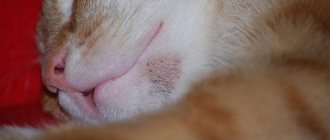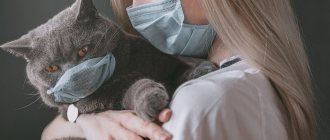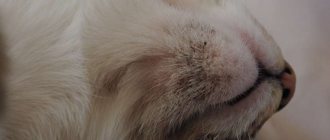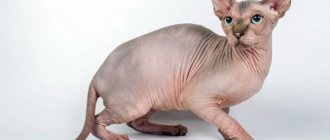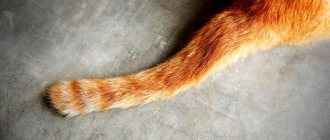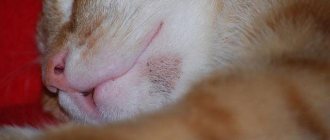- What causes acne?
- How does acne appear?
- Modern approaches to acne treatment
The appearance of black dots on a cat's chin does not cause concern to every pet owner. This approach to the condition of a pet’s skin is easily explained by the fact that blackheads or acne, it would seem, do not in any way affect the cat’s health and do not affect its general well-being. In fact, acne in cats, the treatment of which must be comprehensive, indicates not only health problems in the pet. In cases of bacterial infection, inflammation may develop with the formation of purulent foci, subcutaneous abscesses, phlegmon, and the like.
What is acne?
Acne in cats is not a very common disease. Therefore, the appearance of acne in the area of the chin, abdomen, mouth, ears and base of the tail causes some surprise in a person.
This dermatological pathology is associated with improper functioning of the sebaceous glands - as a result, pores are clogged and a serious disturbance in metabolic processes occurs.
The pores are closed by old epithelium, which is glued to new cells by fatty secretions. This causes black or white pimples to form. The type of rash depends on where the blockage occurs and the sebaceous plug appears - inside or outside the pore. If the process is not accompanied by infection, the skin problem may disappear on its own.
What to do at home
Like other cat diseases, acne can be treated as prescribed by your veterinarian.
In order for the therapy to give the expected result, the owner needs to understand why the normal functioning of the sebaceous glands on the cat’s body has been disrupted. To do this, it is necessary to follow all the recommendations prescribed by the doctor and, after the course of therapy, establish control over the introduction of new foods, especially fatty ones.
It is important to remember that excess vitamins can also cause acne outbreaks. Therefore, vitamins also need to be given in doses.
It is necessary to monitor the hygiene of the dishes, and also wipe the cat’s chin after eating, which is difficult to lick on its own. You can wipe it with a cotton swab dipped in a decoction of calendula or chamomile.
Causes of acne
The appearance of skin pathologies accompanies animals of different ages and breeds. Anomalies in the functioning of the sebaceous glands most often affect furry cats with weakened immune systems and poor living conditions. In advanced cases, the animal experiences great discomfort, which later develops into infectious diseases and dermatitis. It has been established that the appearance of acne in cats has different causes; they can be conditionally divided into two large groups - external and internal.
External factors
Veterinarians cannot absolutely accurately name the problems that lead to dermatological pathologies. One of the most common external factors in the appearance of acne is considered to be improper or insufficient care of the owner for his pet.
Acne on a cat's chin occurs because it is difficult for her to lick this part herself. As a result, sebaceous plugs oxidize and clog skin pores. Other causes of acne in cats are:
- improper diet;
- taking certain medications;
- experienced stressful conditions;
- poor place of detention - too humid, stuffy, etc.;
- dirty place for the cat to feed and rest.
Interestingly, skin diseases also appear as a reaction to surrounding objects. For example, a negative reaction is caused by low-quality plastic, from which bowls for eating and drinking are made. Daily contact with such material leads to the appearance of black spots on the chin of a pet.
At-risk groups
Some experts claim that the causes of acne in cats are not related to the gender, age or breed of the mustachioed friend, while others talk about certain patterns. For example, animals after undergoing sterilization and castration are least susceptible to blockage of the sebaceous glands.
Long-haired individuals are more likely to suffer from acne, which appears in the folds and on the face. In animals with short hair, inflammation occurs mainly on the chin. Black dots are most visible in bald individuals who have increased sebum secretion.
Which breeds are more susceptible
Skin pathologies in the form of acne are common in cats of different breeds, different ages, and different genders.
Of course, at risk will be those cats who:
- tableware hygiene is not observed;
- the diet is not adjusted towards a balance of microelements, vitamins and nutrients;
- there is no control over the cleanliness of the skin, including in places that are difficult to lick.
Symptoms, distinctive features, stages
Sometimes black spots on a pet's skin form and disappear without the owner noticing. This is explained by the fact that the mustachioer does not experience any discomfort and does not scratch the problematic part of the body. Acne goes away on its own thanks to a strong immune system.
However, repeated inflammation causes significant suffering for the furry ones. An attentive owner will notice the changes that occur on the animal’s body.
In addition, the behavior of the mustache also changes. He is constantly irritated, becomes restless, begins to refuse food, and is constantly itching. External symptoms may go through the following stages:
- Initially, redness of the skin appears.
- There are more pimples, and in appearance they look like dirt on the fur.
- The affected part of the body begins to swell and increase in size.
- Gradually, ulcers and inflammation of the follicles appear.
- Crusts of pus and blood form on scratched areas.
- The last stage is the loss of fur in the affected areas.
It is important to notice dermatological problems with your pet’s skin at the initial stage. If the owner takes action in time, the patient will get rid of the pathology much faster. Relapse is caused by incorrect or delayed treatment.
Possible complications
If you do not provide qualified assistance to your cat in a timely manner and allow the formation of blood wounds after scratching acne areas, then a secondary infection may develop on the skin. Damaged skin is a gateway for infection; any fungus or bacteria will complicate the pet’s condition.
The right decision would be for the animal owner to contact the clinic at the initial signs of the disease, avoiding re-infection.
On what parts of the body do blackheads usually appear?
Sebaceous glands are located throughout the pet's body. Owners online show cat acne in photos, and there it is most often localized in the area of the lips and chin.
If the pathology remains unnoticed, then acne can subsequently spread to other parts of the cat’s body. Particularly affected are areas that are constantly exposed to dirt or cannot be thoroughly cleaned. For example, the area around the tail, armpits, nose and bridge of the nose.
Clinical symptoms
Sores in cats are localized mainly on the lower jaw. Sometimes, in addition to the beard, black specks can be found along the line of the upper and lower lips.
At the first stage of the disease, clinical symptoms are noticeable only in hairless cats in the form of small dirty dots. In 50-55% of cases, no further development of pathology occurs, and the animals do not show concern.
In 45% of cases, feline black comedones on the cat's chin progress to sores such as papules and pustules. Their symptoms are:
- the appearance of red spots on the skin of the chin;
- formation of painful tubercles;
- the appearance of a spherical or cone-shaped abscess, upon pressing on which a certain amount of purulent exudate is released.
If squeezing out the abscess and its subsequent treatment was carried out in compliance with antiseptic rules, then after 2-3 days a dry crust appears in place of the pustule. After its removal, no scars remain.
However, quite often the cat scratches the abscess on its own, which provokes the development of a secondary infection and the formation of a boil. Clinically this manifests itself:
- hyperemia and swelling of the chin tissue;
- an increase in local temperature;
- itching and soreness, which provoke further scratching;
- thickening of the skin in the lower jaw area.
After the completion of the process of maturation of the boil and the formation of a connective tissue capsule around it, pain and itching go away, the temperature returns to normal, and the purulent exudate is visible through a thin layer of skin.
Carrying out diagnostics
It is impossible to find out for yourself what kind of black marks appeared on the body of a pet. Even with some experience and knowledge, the patient’s owner will not be able to make an accurate diagnosis. To determine the nature of the skin rash, you must consult a veterinarian.
The doctor will examine the patient and find out details about the animal’s nutrition. Information about the last vaccination and deworming performed will be important for making a diagnosis. For an accurate clinical picture, diagnostic procedures can be performed:
- Scraping from the diseased area to determine the pathogenic microorganism.
- Blood sampling for serological analysis aimed at excluding other similar diseases.
- Bacteriological culture to determine the type of pathogen.
- A biopsy prescribed to identify benign or malignant neoplasms.
As a result, the veterinarian will have all the data to make an accurate diagnosis and develop a treatment regimen. The therapy prescribed by the doctor will be aimed at symptomatic elimination of skin manifestations and relief of negative consequences.
Prevention of streptoderma
To reduce the likelihood of developing streptoderma in a child, follow the rules of prevention:
- observe the rules of hygiene;
- treat skin lesions with antiseptics;
- strengthen your immune system with vitamin complexes and good nutrition;
- do not wash your child with soap too often;
- At the first symptoms of any disease, consult your doctor.
Streptoderma is a curable disease, but you need to see a doctor in time. The sooner treatment is started, the easier it is to avoid complications and transition to a chronic form. You can undergo a qualitative examination of your skin condition at the SM-Doctor clinic. Qualified pediatric dermatologists will make the correct diagnosis and prescribe the correct treatment.
How to cure cat acne
Acne in cats can be treated at home. If you strictly follow the prescriptions and recommendations of the veterinarian, you will be able to help your sick pet quickly enough.
The choice of medications is explained by the age, characteristics of the patient’s body, as well as the complexity of the clinical picture of the disease. If a repeated manifestation of skin pathology is recorded, then the prescribed drugs are much more aggressive. It is important for the owner to follow the recommendations on the dosage and duration of medication use.
Ointments, shampoos and folk remedies
The veterinarian prescribes local or complex therapy. When diagnosing acne in cats, the doctor determines how to treat the patient. Therapy depends on the frequency of skin rashes and the severity of the disease. The main recommendation from a specialist is not to squeeze out mature acne and not to self-medicate. The following can be used as effective medicines:
- Percutan ointment
, applied twice a day until the problem disappears completely. Furacilin, which is the main component of the drug, dyes the hair yellow; there is no need to be afraid of this.
- Mupirocin ointment
(Bactroban), used to treat damaged areas during re-infection, formation of purulent and bloody crusts.
- Prednisolone ointment
is prescribed in case of severe inflammation, as it contains powerful substances - corticosteroids. They have a strong anti-inflammatory and healing effect.
Doctors do not recommend frequent use of antiseptic compounds: chlorhexidine, hydrogen peroxide, miramistin, boric or salicylic alcohol, iodine. Their constant application leads to dry skin. Instead, they are treated with shampoos and soaps with antiseborrheic properties. For example, tar soap has proven itself well.
As additional measures, you can use folk remedies. To get rid of blackheads and inflammation, prepare an infusion of chamomile and calendula, in which two furatsilin tablets are dissolved. Apply the liquid to the affected parts twice a day. Pieces of fresh pumpkin, which are used to wipe acne three times a day, help well.
Diet
You can speed up the treatment of cat acne with the right diet. The veterinarian immediately prescribes a diet of low-fat foods. During therapy, as in ordinary life, it is impossible to feed the patient food from the master’s table. Such food contains a large amount of preservatives and flavor enhancers that are harmful to pets.
The patient's diet should consist of foods that do not cause allergies: lean meat, offal, cereals. As auxiliary elements, the pet is given vitamin and mineral supplements, Omega-3 and Omega-6 acids.
If the cat eats commercial food, the doctor will recommend a low-fat dietary product in the form of granules or pates.
Hygiene procedures
Getting rid of acne in cats using home treatment without veterinarian advice is difficult. Only in combination with hygienic procedures and proper conditions for keeping the patient is a guaranteed cure possible.
Acne in cats on the chin without treatment leads to the formation of large ulcers. Without proper hygiene, pathogenic microorganisms will penetrate inside and lead to complications. What actions should be taken to maintain hygiene:
- Treat affected parts of the body with medicinal ointments prescribed by a veterinarian.
- Before using the preparations, disinfect the skin with a 3% solution of hydrogen peroxide - if there are wounds.
- For long-haired pets, it is necessary to trim or shave the hair on the affected area during treatment.
- If the points are located on the face (for example, on the chin), after eating you need to wipe your pet’s mouth to remove food debris.
It is important to pay attention to what your pet comes into contact with. It is advisable to replace plastic bowls for water and food with iron, ceramic or glass. If your furry dog wears a collar, it must be removed during treatment. This will avoid rubbing the affected areas and re-infection.
Do I need to contact a veterinarian?
Only a veterinarian can determine the nature of the appearance of skin rashes on the body of an animal. Examination of the patient and conducting additional studies are of great importance for making the correct diagnosis.
Skin scrapings and analysis for the presence of fungal or parasitic diseases will help to exclude diseases with similar symptoms: scabies, granuloma, allergies, demodicosis, dermatophytosis.
The structure of animal skin
The skin is the largest organ of a cat, the weight of which, depending on the species, age, and nutrition of the animal, ranges from 12 to 24% of its weight. It protects internal organs from the negative effects of the external environment, regulates body temperature, acts as an organ of touch, and performs other important functions.
The skin of a cat consists of three layers:
- epidermis;
- dermis;
- subcutaneous tissue.
Epidermis
The outer layer of the skin is the epidermis, consisting of keratinized scales. It is constantly updated. The scales leave the body when they are pushed out by young cells coming from below (the process of keratinization).
The layer is durable, elastic, capable of retaining water, salts, nutrients, and preventing infection from entering the body. There are also cells associated with whiskers and hair follicles that improve the sense of touch.
It is the epidermis that is damaged more often than others. With weak immunity, he may succumb to infection and sunlight. Fleas and ticks attack him first, gnawing holes.
basement membrane
The epidermis is separated from the next layer, the dermis, by a thin basement membrane. It is involved in cell regeneration and affects their metabolism. The elasticity of the cover depends on its integrity. Some diseases of the epidermis, as well as a number of autoimmune skin diseases of cats and dogs, can damage the membrane and disrupt its functions.
Dermis
The dermis produces collagen, which maintains skin tone. Also here is:
- A network of blood vessels through which the dermis nourishes the epidermis, fur, claws, and regulates body temperature.
- Sensory and motor nerves through which the body reacts to cold, heat, itching, pain.
- Immune cells that trap infectious agents that have been able to pass through the epidermis.
Subcutaneous layer
Subcutaneous tissue is the innermost layer. It contains subcutaneous fatty tissue, which provides insulation, is a shock absorber, and a reservoir for liquids, electrolytes, and glucose.
Wool
One of the appendages of the skin is wool. Hair follicles in adult pets are complex - they have a central hair surrounded by small hairs that come from one common pore.
Their growth and condition are affected by nutrition, hormones, molting, and health. The sebaceous glands secrete a secretion that moisturizes the skin and makes the coat soft and shiny. The color of the coat can vary depending on the time of year, temperature changes, and the amount of sunlight.
Wool protects the animal's skin from physical damage and ultraviolet radiation. It helps regulate body temperature, so it's longer in winter. In summer, the coat is not only shorter, but also has fewer secondary hairs, allowing air to pass through it calmly, cooling the skin.
Cat claws
Another appendage is the claws. The cat uses them as a tool for protection, catching prey, holding meat, and climbing. By contracting the tendons, it can retract or extend them back and forth.
The dangers of cat acne
Pathologies caused by blockage and further inflammation of the sebaceous glands are not always considered by owners to be serious problems. However, acne should not be left unattended.
For the animal itself
The pet experiences great discomfort from the accumulation of black spots on the chin, around the nose, mouth, and at the base of the tail. The cat scratches the affected areas of the body and brings dirt into the wounds. As a result, purulent ulcers and crusts of blood are formed. Pathogenic microorganisms can penetrate through them, causing dangerous infections that are long and difficult to treat.
For man
The skin pathology, which is unpleasant for the pet fluffy, is not contagious to the owner and his family members. Only infections that accompany an advanced form of illness (for example, lichen) can be dangerous to humans. Therefore, it is impossible not to treat and allow further spread of acne throughout the animal’s body.
General information
Streptoderma is a disease caused by streptococci.
Damage to the skin is characterized by the appearance of a rash. Blisters and ulcers form on the surface of the skin, which itch and cause discomfort. Streptoderma in children can be acute or chronic. The first is characterized by an aggressive course with severe symptoms. Chronic is characterized by periodic exacerbations and periods of subsidence of the inflammatory process.
Based on the depth of the lesion, streptoderma is divided into superficial, deep and intertriginous (the rash develops in the skin folds). Each of the forms has its own characteristics.
Prevention of acne in cats
The task of any owner is to provide proper care for his mustachioed friend. Thus, water and food bowls should be washed once a day and new food should not be added to a plate with old food.
Drinking water should always be fresh. If your pet has a tendency to form black spots, then after each meal you need to wipe its face.
Blackheads in cats usually affect the chin and areas around the mouth. Most owners do not attach importance to this skin disease, hoping for their pet to heal on its own. But lack of attention to this pathology can lead to serious problems. In order not to aggravate the situation, the owner must know the causes and methods of treating blackheads.
The article is for informational purposes only. Contact your veterinarian!
Do you like the article? 181

